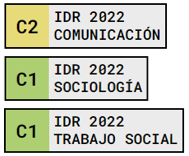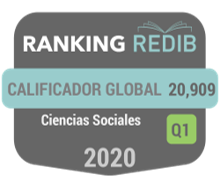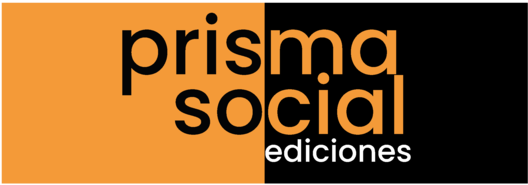The youtuber movement in spanish scientific dissemination
Keywords:
Science popularization, YouTube, Spain, professionalization, influencers, youtubersAbstract
This research establishes an exhaustive radiography of the youtubers that make up the community of scientific disseminators on YouTube Spain and the content of their channels. Using a mixed methodology (quantitative and qualitative) and, according to criteria previously established by González et al. (2020): maintheme, number of subscribers, foundation, number of videos, average duration, views..., the 50 channels thatmake up the first sample are examined. Subsequently, a detailed analysis of a set of profesional youtubers (influencers), second simple studied, under the requirements of González et al. (2020): style "videoblog" and system of micro patronage Patreon. Finally, their digital identities (profiles) are described, as well as their audiovisual contents and communicative methods based on the studies of Sabich and Steinberg (2017). The results give us a prototype of a male, Young scientific communicator with higher education that employs both animations and his personal image as effective communication tools. It is also resolved that, although there are more channels dedicated to exact and natural sciences than to social and human sciences, the topic does not determine the informative effect on the audience, but this is due to the proper use of youtuber’s image and communicative methods.
Downloads
References
Allgaier, J. (2016). Science on YouTube: What users find when they search for climate science and climate manipulation. Arxiv. https://cutt.ly/TgdEvIy
Arrieta, E. (2018). Ciencias naturales y ciencias sociales. Diferenciador. https://cutt.ly/BgdERj0
Burgess, J. & Green, J. (2009). YouTube: Online Video and Participatory Culture. Polity Books.
Canal Gaztea. (2018). Qué es Twitch y cómo funciona. https://cutt.ly/GgdEUiz
Castillo, J. M. (2016, 15 mayo). ¿Pasa por YouTube el futuro de la televisión? Poliantea, 12(22), 147–175. https://cutt.ly/lgdEOsU
Erviti, M.C. y León, B. (2014). La comunicación de la ciencia a través del vídeo online: contenidos populares en Youtube. En J. Sierra y D. Rodrigues (coords.), Contenidos digitales en la era de la sociedad conectada (pp. 129-146). Fragua.
Escandón, P. (2018, 2 de febrero). Clásica y pasteles para celiacos. El País. https://cutt.ly/GgdEGEy
Fernández, Y. (2019, 14 de febrero). Patreon: qué es, cómo funciona y cómo apoyar a tus creadores favoritos. Xataka. https://cutt.ly/pgdEH88
Fundación Española para la Ciencia y Tecnología (2012). Percepción Social de la Ciencia y la Tecnología en España. Consultado el 1 de julio de 2020. https://cutt.ly/ygdEKC4
Fundación Española para la Ciencia y Tecnología (2018). Percepción Social de la Ciencia y la Tecnología en España. Consultado el 1 de julio de 2020. https://cutt.ly/HgdEZxd
Flinker W. & Bienvenido, L. (2019). The power of storytelling and video: a visual rhetoric for science communication. JCOM: Journal of Science Communication, 18(05). https://cutt.ly/9ganlFe
Gamero, R. (2009). La construcción de la identidad digital. EnterIE, (131). https://cutt.ly/QgdECZ4
Giones, A. y Serrat, M. (2010). La gestión de la identidad digital: una nueva habilidad informacional y digital. BiD: textos universitaris de biblioteconomia i documentació, (24). http://dx.doi.org/10.1344/105.000001545
González, R., Serrano, L., Roca, D. (2020). Perfil de las youtubers españolas dedicadas a la divulgación científica. En Fórmulas comunicativas de vanguardia. Editorial: Pirámide.
Hidalgo-Marí, T. y Segarra-Saavedra, J. (2017). El fenómeno Youtuber y su expansión transmedia. Análisis del empoderamiento juvenil en redes sociales. Fonseca: Journal of Communication, 15, 43–56. https://acortar.link/qEGqt
IAB Spain (2020). Estudios Redes Sociales 2020 (versión reducida). Madrid, España. Consultado el 10 de octubre de 2020. https://cutt.ly/kgdRqqG
IONOS (2020). Socialblade: datos de redes sociales a la carta. Consultado el 4 de julio de 2020. https://cutt.ly/YgdRt05
Kavoori, A. (2015). Making sense of YouTube. Global Media Journal, 13(24), 1-25. https://cutt.ly/YggLdbI
López, B. (2020). Cómo ganar dinero en YouTube – Las 7 mejores fórmulas. Ciudadano 2.0. https://cutt.ly/6gdRpUW
López, J. L. (2019). El fenómeno de los edutubers. Estudio sobre las habilidades comunicativas de los youtubers educativos más populares (tesis doctoral, Universidad Austral). https://cutt.ly/VgdRfBv
Martínez, A. (2018, 21 de julio). El 'youtuber' que te da la música mascada. El Periódico de Catalunya. https://cutt.ly/NgdRl4V
Muñoz, J., Czurda, K. & Robertson, C. Y. (2016). Typologies of the popular science web video. JCOM: Journal of Science Communication, 15(04). https://doi.org/10.22323/2.15040202
Pérez P. (2019). Cómo se consume YouTube en España. Think with Google. https://cutt.ly/RgdRn8p
Pérez, V., Pastor, Y. y Abarrou, S. (2018). Los youtubers y la construcción de la identidad adolescente. Comunicar, 55, 61-70. https://cutt.ly/6gdRYjG
Pole, K. (2009). Diseño de metodologías mixtas. Una revisión de las estrategias para combinar metodologías cuantitativas y cualitativas. Renglones, 52(33). https://cutt.ly/DgdRICp
Portaltic (2020). El consumo de vídeo en YouTube aumenta un 55% durante el confinamiento en España. Portaltic. https://cutt.ly/fgdRAZ5
Priest, S. (2015). ¿Qué tienen de científico las ciencias sociales? Metode. https://cutt.ly/FgdRDhc
Rego, S. y Romero-Rodríguez, L. (2016). Representación discursiva y lenguaje de los youtubers españoles: estudio de caso de los gamers más populares. Index Comunicación, 6, 197–224. https://acortar.link/XChw8
Roca, D. (2017). La divulgación científica en la Universidad desde su contextualización histórica: Estudio de caso y propuesta de un modelo de divulgación para la Universidad de Murcia (Tesis de doctoral). Universidad de Murcia, Murcia.
Roqueplo, P. (1983). El reparto del saber. Ciencia, cultura, divulgación. Gedisa.
Rosenthal, S. (2017). Motivations to seek science videos on YouTube: free-choice learning in a connected society. International Journal of Science Education, 8, 1-18. 10.1080/21548455.2017.1371357
Sabich, M.A., y Steinberg, L. (2017). Discursividad youtuber: afecto, narrativas y estrategias de socialización en comunidades de Internet. Revista Mediterránea de Comunicación, 8(2), 171-188. https://cutt.ly/WggJIkw
Scolari, C. y Fraticelli, D. (2016). Nuevos sujetos mediáticos en el ecosistema de medios [ponencia]. V Congreso ASAECA, Argentina. https://cutt.ly/5ggtCyI
Socialblade (2020). Top 500 Subscribed YouTube Channels (Sorted by Subscriber Count). https://cutt.ly/RgdRGZA
Vera, J.J. y Roca, D., (2018). Creación de la marca personal del divulgador científico a través de la web. En José Luis Zurita, Javier Serrano-Puche Marta Gil Ramírez (Eds.). Comunicación periodística ante los nuevos retos (pp. 507–522). Gedisa.
Downloads
Published
How to Cite
Issue
Section
License
Those authors who publish in this journal accept the following terms:
-
Authors retain copyright.
-
Authors transfer to the journal the right of first publication. The journal also owns the publishing rights.
-
All published contents are governed by an Attribution-NoDerivatives 4.0 International License.
Access the informative version and legal text of the license. By virtue of this, third parties are allowed to use what is published as long as they mention the authorship of the work and the first publication in this journal. If you transform the material, you may not distribute the modified work. -
Authors may make other independent and additional contractual arrangements for non-exclusive distribution of the version of the article published in this journal (e.g., inclusion in an institutional repository or publication in a book) as long as they clearly indicate that the work was first published in this journal.
- Authors are allowed and recommended to publish their work on the Internet (for example on institutional and personal websites), following the publication of, and referencing the journal, as this could lead to constructive exchanges and a more extensive and quick circulation of published works (see The Effect of Open Access).


















